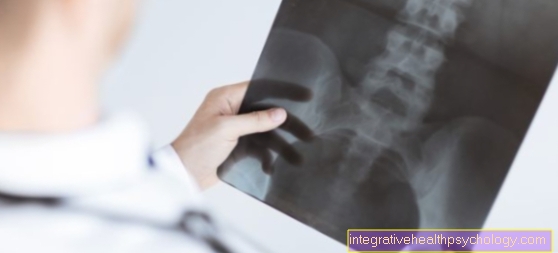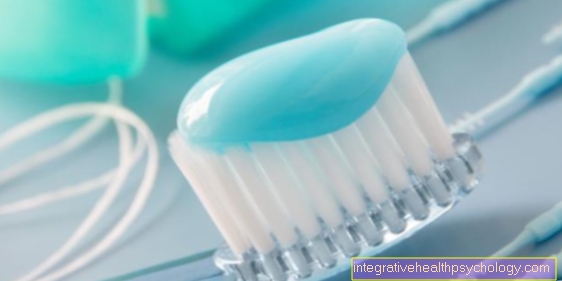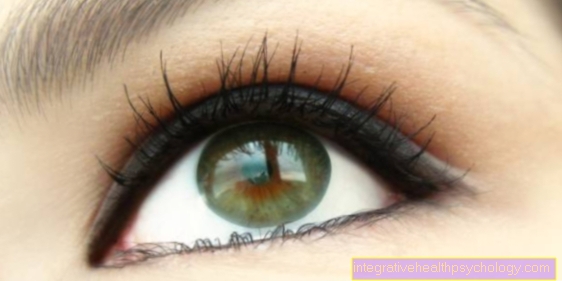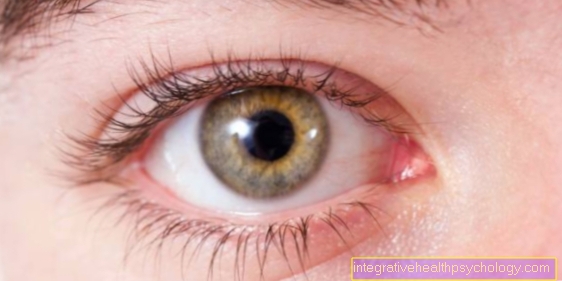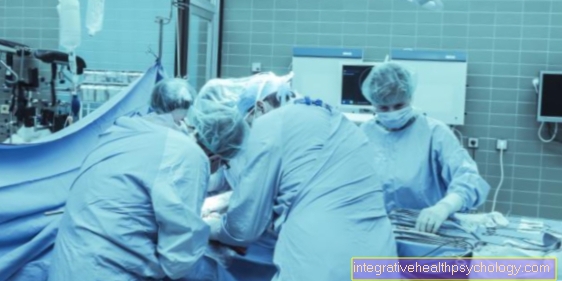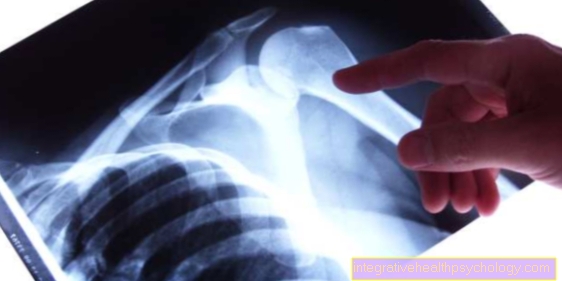Changing teeth in children
introduction
In almost all mammals, including humans, the mouth is with the birth initially toothless. Nature probably arranged this to avoid painful suckling. Gradually the first appear teeth and form that Milk teeth with children.
Read on under: Development of the child

Milk teeth
The first teething, that Milk teeth, consists of 20 teeth, 5 in each quadrant. There are 2 incisors, 1 canine and 2 deciduous molars per quadrant.
The lower deciduous molars have 2 roots and the upper 3 roots. At birth, the teeth are already in Jawbone but they only gradually break through the oral mucosa. Teething generally starts at 6 months.
The central lower incisors appear first. This is followed by the upper 4 incisors, then the two lower lateral incisors, the first Molars, the canines and last the second molars
Teething is usually completed by the age of 2. However, there are also significant individual time deviations. So already with the birth teeth already exist or the period of the dentition is delayed until the age of 3.
These deviations shouldn't be a cause for concern. If all teeth have erupted, it is also normal occlusion (Bite closure) manufactured. Breaking teeth through the mucous membrane can be painful for many children. Against this there is Medicationapplied to the mucous membrane, relieve pain.
Even if the teeth are all in the Oral cavity their root growth is not yet fully completed. This only happens gradually. The Milk teeth are much smaller than the permanent teeth and particularly prone to Carieswhich, also because of the thin layer of enamel, progresses faster than in permanent teeth.
Therefore, the dentist should be visited as early as possible in order to carry out treatment at an early stage. If milk teeth have fallen out prematurely due to carious destruction, the gap should be kept open with a gap holder in order to leave space for the permanent teeth.

I - right upper jaw -
1st quadrant (11-18)
II - left upper jaw -
2nd quadrant (21-28)
III - lower jaw left -
3rd quadrant (31-38)
IV - lower jaw right -
4th quadrant (41-48)
- 1. Incisor -
Dens incisivus I - 2nd incisor -
Dens incisivus II - Canine tooth -
Dens caninus - 1st molar tooth
Anterior tooth (premolar) -
Dens premoralis I. - 2. Anterior molar
Anterior tooth (premolar) -
Dens premoralis II - 1st molar tooth -
Dens molaris I - 2nd molar tooth -
Dens molaris II - Wisdom tooth (= 3rd molar) -
Dens molaris tertius
(Dens serotinus)
1st - 3rd are front teeth
(3 per quadrant)
4th - 8th are molars
(5 per quadrant)
You can find an overview of all Dr-Gumpert images at: medical illustrations
Mixed dentition
It starts at the age of 6 Mixed dentition, so the actual change of teeth. The first large molars appear behind the last milk tooth. They are therefore also called 6-year molars. Since no milk teeth fall out for this, they are often not perceived as permanent teeth.
At the age of 7, the milk teeth begin to wobble and finally fall out at the end of the tooth change. By dissolving the root in the end only that remains Dental crowns left over that either fail on their own or are easy to remove. Before that, gaps formed between the teeth as a result of the jaw growth. This is necessary to make room for the permanent teeth.
If milk teeth remain in place for too long, they must be removed so that the permanent teeth have enough space and positional anomalies are avoided. Between the ages of 7 and 9, the deciduous incisors are replaced by permanent teeth. Canines and small molars appear between the ages of 10 and 13. The last to break through is the second large molar. The deciduous dentition is then completely through the permanent one denture replaced and completed the period of mixed dentition.
They take a special position Wisdom teeth a. They can still break through until the age of thirty and represent the end of the tooth change. However, there are exceptions here too, because in some people they are not applied at all or they remain in the bone because there is no longer any space in the row of teeth.
Permanent dentition

The second dentition, the complete permanent set of teeth including the wisdom teeth, consists of 32 teeth.
They are also divided into 4 quadrants.
In each of these quadrants there are:
- 2 incisors (Incisivi)
- 1 canine (Caninus)
- 2 small molars (Premolars) and
- 3 large molars (Molars).
The lower large molars have 2 Roots, the top 3 roots. All others have 1 root. After breaking through the gums, the crown is already fully formed, but the roots are still developing. The root canal is still wide and wide open towards the tip of the root. Only gradually do the roots develop fully.
The correct position of the row of teeth can be disturbed by deciduous teeth not falling out in time or deciduous teeth lost too early. In these cases, the permanent teeth find their place occupied or the gap is too narrow and they then break through behind the row of teeth and have to be brought back into position by orthodontic measures.
Problems changing teeth
Numerous problems can arise in the formation and development of permanent teeth.
It is particularly common that permanent teeth, due to a jaw that is too small, have too little space to break through in their intended place. In this case, the orthodontist and dentist work together, so that the dentist pulls teeth to make room, while the orthodontist uses the space to straighten all of the teeth with "braces".
If the hard palate is too small due to insufficient upper jaw growth, then the teeth have no space and if the lower jaw is normally developed, a wrong clenching occurs: the lower jaw teeth bite in front of the upper jaw teeth. The bite misalignment is corrected by stimulating the growth of the upper jaw and then repositioning the teeth. This process is called palatal expansion.
Furthermore, teeth can erupt crookedly and stand crooked or in gaps if there is too much space. This can be the case if teeth or groups of teeth are not created. In many cases, the lateral incisor or a premolar is missing.
In addition, the bite position can interfere with changing teeth. For example, if the lower jaw is in front of the upper jaw and not the other way around, as would normally be the case, then it prevents the upper jaw from further growth and the teeth shift. Disturbances in the development of bones in the upper and lower jaw, such as cleft lip and palate, can have a negative impact on tooth development, whereas countermeasures must be taken early on.
Due to the many factors that can negatively affect the development of the teeth, it is advisable to go to an orthodontist for a check-up between the ages of 7 and 8, unless the dentist has already advised this. This can then counteract disturbances at an early stage, which is faster and gentler in the early stage due to growth than after growth has ended.
This article might also interest you: Molar Incisive Hypomineralization
At what age do children change their teeth?
In general, there are characteristic tooth eruption times, but there is no immediate need for treatment if teeth develop a little later or earlier than according to the textbook, as every child develops differently.
- The first permanent tooth to erupt is that 6 year molar. The first molar represents the beginning of the permanent dentition's development.
- They break at the age of 6 and 7 Incisors by.
- As a rule, nothing visible happens between the ages of 8 and 9. During this period the root of the teeth of the second phase of tooth development below the gums. During this time you are practically prepared for the breakthrough.
- The remaining teeth come between 10 and 11 years of age, until the second phase of tooth development with the second molar, the 12-year molar concludes. With this, the tooth development is already completed in many cases.
- From the age of 16 it can be that the Wisdom teeth break through, which, however, do not have to be created and often have no space or are displaced and therefore cannot come out of the gums.
If all teeth are fully developed, it is advisable to take a large X-ray, take a panoramic layer image of the teeth to clarify whether there are wisdom teeth, whether they have enough space and whether they may need to be pulled.
Order of changing teeth
The change from deciduous dentition to permanent dentition can be divided into 2 sections.
The first permanent tooth to erupt is the 6-year-old molar, or the first molar. This is followed by the central and lateral incisors. The lower front teeth are usually a little faster than the teeth in the upper jaw, which was already seen in the development of the primary teeth and is repeated in the permanent set of teeth. This group of teeth characterizes the first phase of tooth change.
In the second phase, the canines, the premolars and finally the 12-year-old molars, or posterior molars, follow.
There is usually 2-3 years between the first and second phase of tooth development, during which the roots of the teeth of the second phase develop completely until they can break through.
The last teeth to break through are the wisdom teeth, which are not created in every human being. Many people lack them partially or completely, as they often no longer evolve at all because they are no longer needed in today's food intake.
You may also be interested in this topic: Wisdom tooth eruption
Homeopathy for mixed dentition
homeopathy is considered a gentle remedy for many ailments. But if you have problems changing teeth, naturopathy cannot help, as many Genetic deformities and cannot be influenced by homeopathic remedies. These primarily include disorders of bone growth or tooth eruption in the event of non-attachment.
Crooked and crooked teeth can only through mechanical corrections be repositioned by the orthodontist. He performs his therapies by shifting the teeth with functional orthodontic devices, popularly Braces. These act as a mechanical correction aid through pressure and tension elements and position the teeth in the correct position. Especially when the orthodontist has activated the braces (i.e. has given renewed pressure or tension on the teeth), it can become too in the first few days Pain come.
There is no scientific evidence that homeopathic remedies will help during this orthodontic treatment, except for possible pain.
So it can be summarized that there are no benefits of homeopathy in tooth development, but there are also no known disadvantages that would have to be stated against its use.
Summary
The mixed dentition represents the transition from the milk teeth to the permanent teeth. As a change of teeth in children, this lasts for several years. Temporal deviations from the norm are possible and harmless. If the milk teeth fail properly, they can be replaced by permanent teeth without complications. Irregularities in the permanent set of teeth can be caused by the Orthodontics be resolved.
Read more about this under "Incisor broken off'.

.jpg)



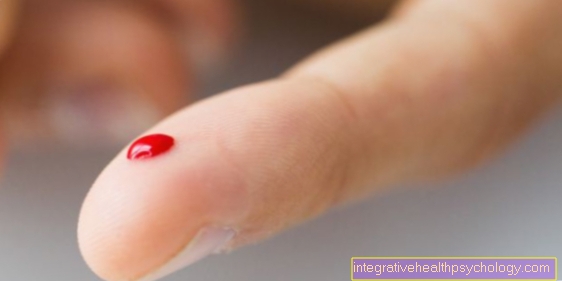







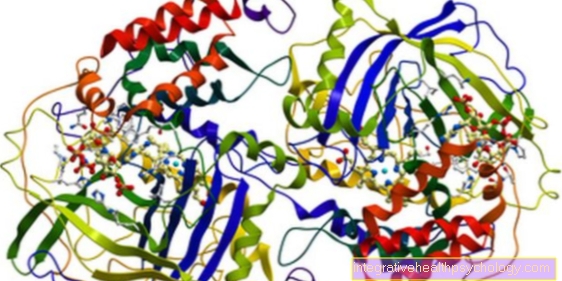
.jpg)






